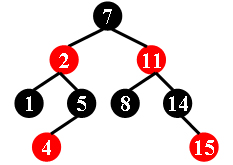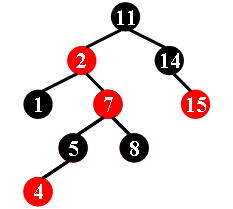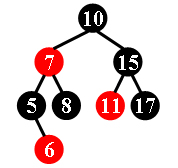There is a kind of balanced binary search tree named red-black tree in the data structure. It has the following 5 properties:
- (1) Every node is either red or black.
- (2) The root is black.
- (3) Every leaf (NULL) is black.
- (4) If a node is red, then both its children are black.
- (5) For each node, all simple paths from the node to descendant leaves contain the same number of black nodes.
For example, the tree in Figure 1 is a red-black tree, while the ones in Figure 2 and 3 are not.
 |  |  |
|---|---|---|
| Figure 1 | Figure 2 | Figure 3 |
For each given binary search tree, you are supposed to tell if it is a legal red-black tree.
Input Specification:
Each input file contains several test cases. The first line gives a positive integer K (≤30) which is the total number of cases. For each case, the first line gives a positive integer N (≤30), the total number of nodes in the binary tree. The second line gives the preorder traversal sequence of the tree. While all the keys in a tree are positive integers, we use negative signs to represent red nodes. All the numbers in a line are separated by a space. The sample input cases correspond to the trees shown in Figure 1, 2 and 3.
Output Specification:
For each test case, print in a line "Yes" if the given tree is a red-black tree, or "No" if not.
Sample Input:
3
9
7 -2 1 5 -4 -11 8 14 -15
9
11 -2 1 -7 5 -4 8 14 -15
8
10 -7 5 -6 8 15 -11 17Sample Output:
Yes
No
No#include<bits/stdc++.h> using namespace std; const int maxn=1010; #define inf 0x3fffffff vector<int> vis; typedef struct node{ int data; struct node *lchild; struct node *rchild; }node,*pnode; void build(pnode &root,int temp){ if(root==NULL){ root=new node; root->data=temp; root->lchild=root->rchild=NULL; return ; } else if(abs(temp)<=abs(root->data)){ build(root->lchild,temp); } else{ build(root->rchild,temp); } } bool judge1(pnode root){ if(root==NULL){ return true; } if(root->data<0){ if(root->lchild!=NULL&&root->lchild->data<0){ return false; } if(root->rchild!=NULL&&root->rchild->data<0){ return false; } } return judge1(root->lchild)&&judge1(root->rchild); } int getNum(pnode root){ if(root==NULL){ return 0; } int l=getNum(root->lchild); int r=getNum(root->rchild); return root->data>0?max(l,r)+1:max(l,r); } bool judge2(pnode root){ if(root==NULL){ return true; } int l=getNum(root->lchild); int r=getNum(root->rchild); if(l!=r){ return false; } return judge2(root->lchild)&&judge2(root->rchild); } int main(){ int n,m; scanf("%d",&n); while(n--){ pnode root=NULL; scanf("%d",&m); vis.resize(n); for(int i=0;i<m;i++){ scanf("%d",&vis[i]); build(root,vis[i]); } if(vis[0]<0||judge1(root)==false||judge2(root)==false){ printf("No "); } else{ printf("Yes "); } } return 0; }